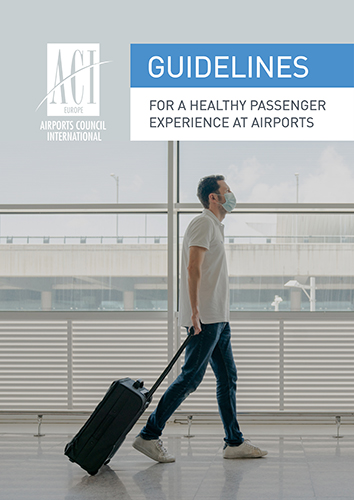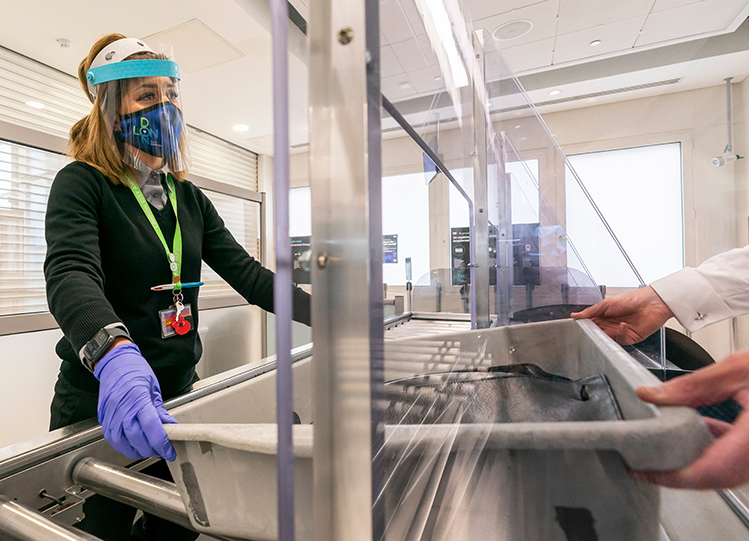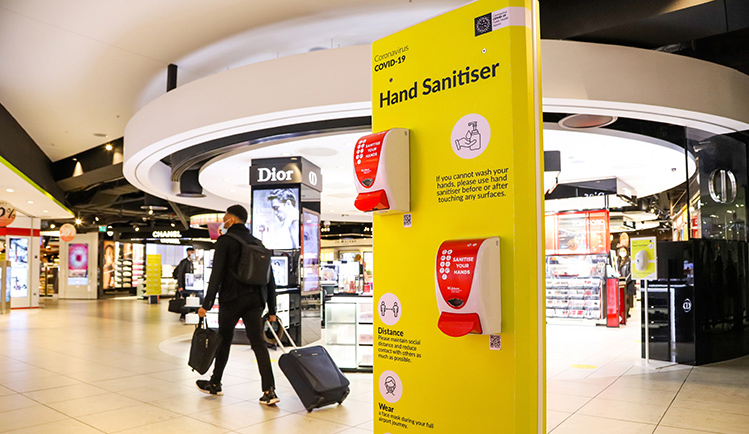ACI EUROPE published its Guidelines for a Healthy Passenger Experience at Airports in July 2020, offering practical step-by-step guidance to airports as they restart operations. Federico Bonaudi, Head of Facilitation, Parliamentary Affairs & Regional Airports, ACI EUROPE, elaborates on what airports need to consider. Interview by Ross Falconer
The ongoing COVID-19 pandemic has had a massive impact on every aspect of our lives and the global economy – and airports are no exception. It is, therefore, natural that the protection of public health, including that of passengers and staff, is of paramount importance to restore air connectivity and safe travel.
Since the early days of this crisis, European airports have worked closely with their stakeholders and the European and national regulators to implement a range of new health and safety protection measures to restart air travel.

ACI EUROPE published its Guidelines for a Healthy Passenger Experience at Airports in July 2020, offering practical step-by-step guidance to airports as they restart operations. The advice is structured around three main components of the passenger experience – the so-called ‘3P Approach’: Premises, Processes and People (staff).
ACI EUROPE’s Guidelines for a Healthy Passenger Experience at Airports, published in July 2020, are the final output of this intense process of stakeholder relations. They are built upon the EASA/ECDC Aviation Health Safety Protocol to elaborate on what airports need to consider and do to implement them.
“Their main objective is to provide airport managing bodies with the tools necessary to ensure that airport premises are clean and safe places for passengers and staff,” explains Federico Bonaudi, Head of Facilitation, Parliamentary Affairs & Regional Airports, ACI EUROPE. “This is done through practical step-by-step guidance to airports as they restart operations based on a ‘new normal’, reviewing all possible actions, methodologies, technologies and implications.”
At the same time, ACI EUROPE’s role in promoting best practices in airport management remains unchanged. “The ultimate objective of the Guidelines for a Healthy Passenger Experience at Airports is to keep driving the airport business towards the key concepts of consumer-centricity and sustainability,” says Bonaudi. “The passenger is, and will continue to be, at the heart of the airport business.”
‘3P Approach’: Premises, Processes and People
The main areas of advice provided in the Guidelines are structured around three main components of the passenger experience – the so-called ‘3P Approach’: Premises, Processes and People (staff).
“In order to make sure that airport managing bodies comply with the EASA/ECDC COVID-19 Aviation Health Safety Protocol, each section clearly identifies the recommendations mentioned in the Protocol, while providing additional guidance and best practices,” Bonaudi comments. “Special attention has been paid to existing and innovative technologies that may be used to help protect the health of passengers and staff.”
In order to ensure that airport premises are safe, the Guidelines provide recommendations to:
- Achieve physical distancing between people
- Ensure an optimal hygiene level through enhanced cleaning and disinfection
- Improve terminal heating, ventilation, and air conditioning (HVAC)
- Enforce the use of face masks
- Install protective screens at touchpoints between passengers and staff
“It has to be noted that it will not be possible to ensure a 1.5m physical distancing among passengers at all touchpoints all the time,” says Bonaudi. “For this reason, the other risk-mitigation measures must not be neglected.”
The “health-concerned passenger”
It is clear that there is a new pattern in passenger behaviour that is likely to persist once the COVID-19 pandemic comes to an end. In this respect, the Guidelines identify the concept of the “health-concerned passenger”.

In order to ensure that airport premises are safe, ACI EUROPE’s Guidelines for a Healthy Passenger Experience at Airports recommend the installation of protective screens at touchpoints between passengers and staff. Photo: London City Airport
“The health-concerned passenger pays special attention to the measures taken to limit the risk of transmission, increase their consumption consciousness at airports (cost, sustainability, reduced human contact) and to continue to embrace technology and touchless solutions,” Bonaudi explains. “At the same time, the health-concerned passenger expects Airport Managing Bodies not only to respond to their needs and expectations, and redefine their relationship with them and the other stakeholders, but also to innovate as much as possible to put in place smart and cost-effective solutions.”
The processes outlined in the Guidelines entail a set of extremely diverse procedures that constitute the core of passenger-related airport activities throughout the end-to-end passenger journey. “For instance, health screening may be a useful tool to control disease spread and minimise the impact on air travel,” says Bonaudi. “It needs to be part of a multi-layered approach, agreed at European level, based on an effective risk-assessment. Testing travellers will of course be a valid option.”
When it comes to the so-called traditional processes, these include pre-travel, access, check-in, boarding pass check, security, border control, customs control, boarding, connections and baggage services. “The use of biometrics, contact tracing apps, artificial intelligence, digital twins, web-mobile applications, wearable devices, contactless touch panels, passenger counting monitoring, and smart restroom technologies, are just some good examples of innovative solutions to transform the passenger journey and address the concerns of the health-related passenger,” Bonaudi explains.
Advocating an EU testing protocol for travel
ACI EUROPE continues to advocate strongly for the implementation of an EU testing protocol for travel as the way forward for the aviation industry. “The uncoordinated and non-harmonised travel restrictions put in place by some European States, in particular quarantines, are akin to the effects of border closures,” says Bonaudi. “They are depriving European citizens of their right to free movement within the EU/Schengen area and are negatively impacting the functioning of the internal market. Above all, they are at odds with the advice of both the European Centre for Disease Prevention and Control (ECDC) and the World Health Organization, who consider travel restrictions to be ineffective in most situations while causing significant societal and economic disruption. Regrettably, testing cross-border travellers is currently not part of an effective response to the pandemic by the European States.”
ACI EUROPE believes that quarantines must be replaced by testing based on an EU Testing Protocol for Travel (EU-TPT) which is consistently applicable for passengers travelling from high risk areas. “Testing cross-border travellers should be based on common criteria, agreed on necessary pre-conditions and mutual recognition,” Bonaudi comments. “In order to be integrated into the travel process, testing must be performed at speed, particularly when testing is to take place at the airport. It must be at a sufficient scale and accurate, with high sensitivity and specificity. It must also be supported by a system of mutual recognition across the EU/EEA/Switzerland and by the UK regulators.”

It is clear that there is a new pattern in passenger behaviour that is likely to persist once the COVID-19 pandemic comes to an end. In this respect, the Guidelines identify the concept of the “health-concerned passenger”. Photo: Dublin Airport
10 key conclusions
The Guidelines provide a series of recommendations that can be adapted, taking into account the specificities of each airport and the national, regional or local requirements. That being said, Bonaudi explains that the key conclusions can be summarised in 10 main points:
- Health concerns will define the experience, confidence, and behaviour of passengers.
- Engage with your passengers and determine their specific needs and expectations at your airport.
- Comply with national, regional and local health legislation.
- Premises: Physical distancing will be required for some time once activities restart.
- Premises: Additional risk mitigation measures are also needed.
- Processes: Existing processes need to be adapted to comply with new requirements.
- Processes: Additional processes may be required at national level.
- Processes: Innovative technologies will be useful to support new actions.
- People (staff) need to be protected.
- Efficient communication of the measures put in place.
The Guidelines have received an excellent response from ACI EUROPE’s members, and their compliance with the EASA-ECDC Aviation Health Safety Protocol has also been acknowledged by the European and national regulators.
Bonaudi adds that, to date, over 100 of Europe’s airports and airport operators have signed and committed to the EASA Aviation Industry Charter for COVID-19 to give feedback on their practical experiences in implementing the protocol. “ACI EUROPE’s members are committed to the protection of the health of passengers and staff, and I would like to take this opportunity to thank them for their hard work and ongoing support.”







